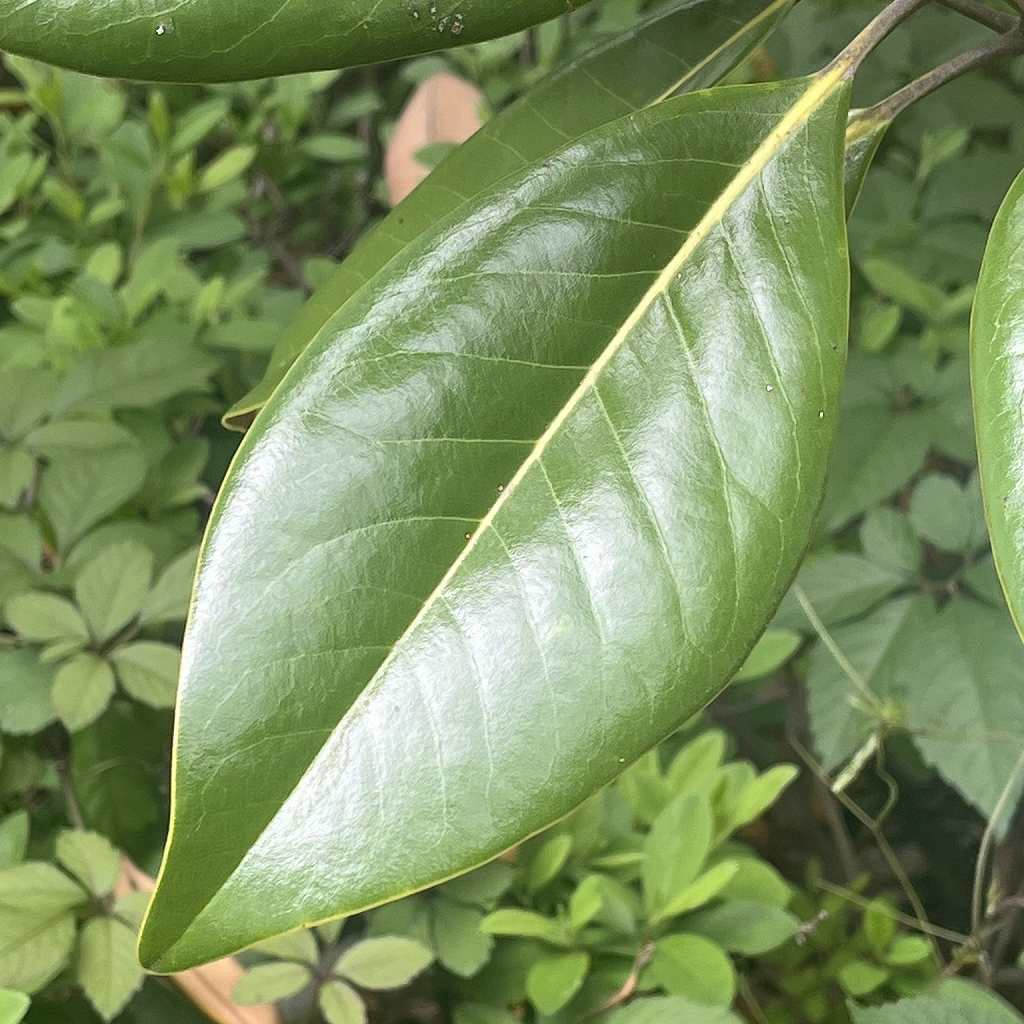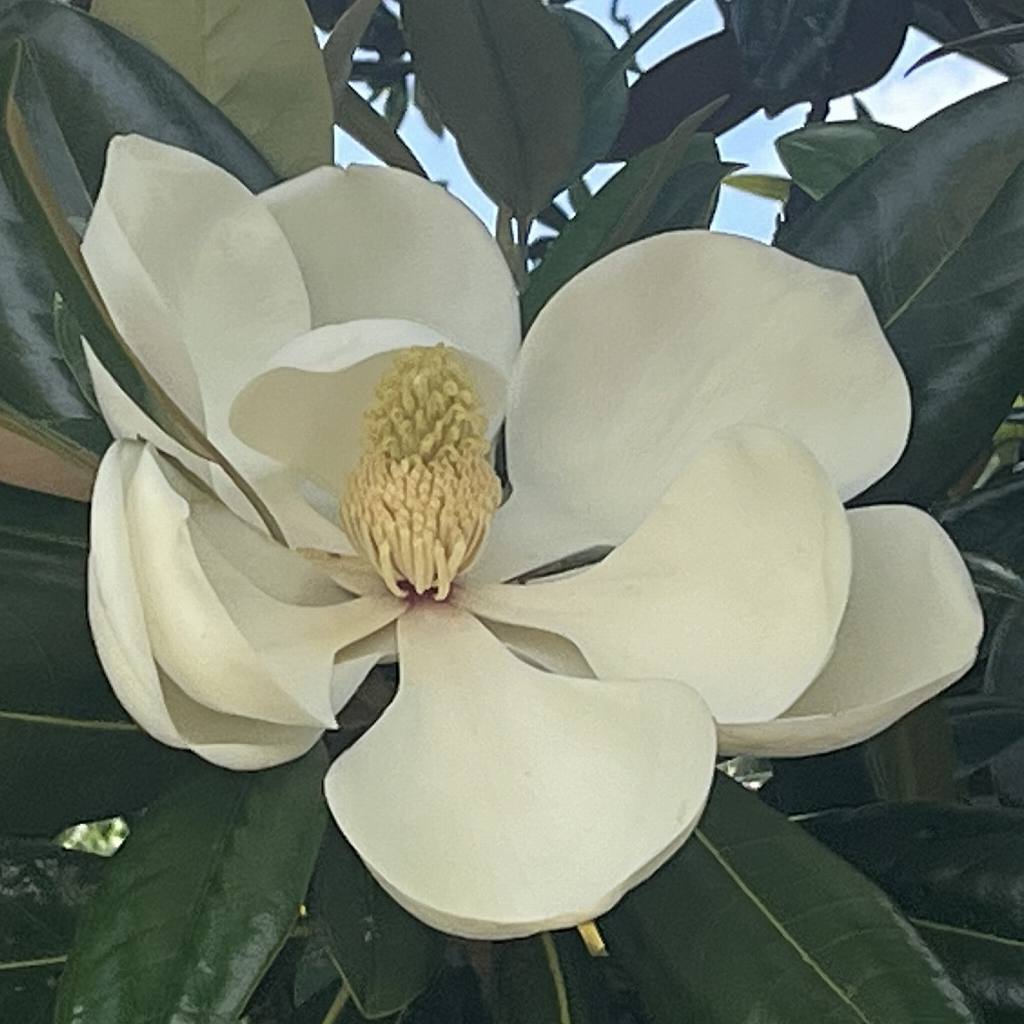タイサンボクの花は高い枝先で上向きに咲き、肉厚の花弁が6枚、萼片が3枚、雄しべも雌しべも螺旋状。爽やかで華やかな芳香が漂います。
Southern Magnolia flowers bloom facing upwards at the tips of tall branches. The flowers have six thick petals and three sepals, and both the stamens and pistils are spiral. They give off a fresh, gorgeous fragrance.
【仮名】タイサンボク
【和名】泰山木, 大山木
【英名】Southern Magnolia, Bull Bay
【学名】Magnolia grandiflora
【誕生】06/ 08
【開花】06, 07月
【花色】White
タイサンボク
タイサンボクの概要

タイサンボクはモクレン科の常緑高木。原産地は北米の南東部で、日本へは明治時代の初期に渡来しました。東京の新宿御苑に植えられ、それが本州全域、四国、九州に拡大。花は高い枝先で上向きに咲き、爽やかで華やかな芳香が漂います。花言葉は「前途洋々」「威厳」「壮麗」。
タイサンボクの名前

タイサンボクの名前の由来は花が大きな盃「盞」のようだから。この大盞に、中国山東省の聖地「泰山」の字が充てられました。ラテン語の属名マグノリアは17~18世紀のフランスの植物学者ピエール・マニョルへの献名。種小名グランディフローラは「大きな花の」という意味です。
タイサンボクの姿形

タイサンボクは木が高く、幹が太く、樹皮が灰褐色です。葉は厚い革質の長楕円形で縁が丸まり、互生。表面に光沢があり、裏面に褐色の毛が密生します。花は肉厚の花弁が6枚、萼片が3枚、雄しべも雌しべも螺旋状。花後は袋状の集合果を結び、熟すと橙色の種子が垂れ落ちます。
タイサンボクの種類

タイサンボクの品種「リトルジェム」は木が低く、葉も花も小さな矮性種。花が若木の頃から咲き始め、春から秋まで咲き続けます。木が小さいから庭植え、鉢植えも可能。葉は表面の光沢、裏面の褐色が目立ち、花も強い芳香を放ちます。品種名は英語で「小さな宝石」という意味。
タイサンボクの近縁

タイサンボクの近縁種「姫泰山木」は原産地が北米南東部で、日本へは昭和初期に渡来。和名の由来は泰山木より木が低く、花が小さいからです。葉は薄く、表面が明るい緑色、裏面が灰白色。暖地以外では冬に落葉します。花は早めに咲いて乳白色。バニラのような芳香があります。
Southern Magnolia

Southern Magnolia is an evergreen tall tree of the Magnoliaceae family. It is native to the southeastern part of North America and was introduced to Japan in the early Meiji period. It was first planted in Shinjuku Gyoen in Tokyo, and then spread throughout Honshu, Shikoku, and Kyushu. The flowers bloom facing upwards at the tips of tall branches, giving off a fresh, gorgeous fragrance. The flower language is “bright future,” “dignity,” and “magnificence.”
The Japanese name of Southern Magnolia means “big cup” and comes from the shape of the flower. The Chinese characters for “Taishan,” a sacred place in Shandong Province, China, were used to create the Japanese name. The Latin genus name Magnolia is a tribute to Pierre Magnol, a French botanist from the 17th and 18th centuries. The specific name grandiflora means “large-flowered.”
Southern Magnolia is a tall tree with a thick trunk and gray-brown bark. The leaves are thick, leathery, oblong, with rounded edges, and alternate. The leaves are shiny on the surface and densely covered with brown hairs on the underside. The flowers have six fleshy petals and three sepals, and both the stamens and pistils are spiral. After flowering, the plant forms a bag-like aggregate fruit, and when ripe, orange seeds drop out.
The Southern Magnolia variety “Little Gem” is a dwarf species with a low tree and small leaves and flowers. The flowers begin to bloom when the tree is young and continue to bloom from spring to autumn. The small tree makes it suitable for planting in the garden or in a pot. The leaves have a shiny surface and a brown underside, and the flowers have a strong fragrance. The name of the variety means “little jewel” in English.
A close relative of Southern Magnolia, “Magnolia virginiana,” is native to southeastern North America and was introduced to Japan in the early Showa period. Its Japanese name means “Petite Southern Magnolia” because the tree is low and the flowers are small. The leaves are thin, bright green on the top and grayish white on the bottom. Outside of warm regions, the leaves fall off in winter. The flowers bloom early and are milky white. They have a vanilla-like fragrance.


